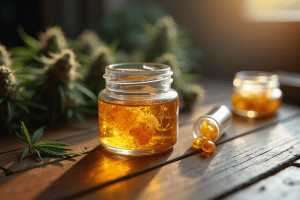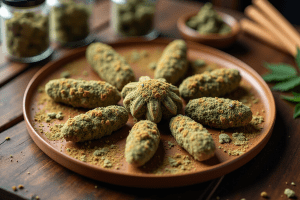Overview
This article delves into Cannabichromene (CBC), a fascinating cannabinoid that deserves our attention. Have you ever wondered about its origins and the benefits it offers? CBC stands out for its therapeutic potential, especially since it does not produce psychoactive effects. This means you can explore its advantages without the high typically associated with cannabis.
Research has shown that CBC plays a significant role in pain management and inflammation reduction. Isn’t it comforting to know that there are options available that focus on wellness? As interest in non-psychoactive cannabinoids grows, it’s clear that many are looking for alternatives that support their health journeys.
However, we must acknowledge that further studies are needed to fully understand CBC’s applications in medical treatments. Together, we can advocate for more research to uncover the full potential of this remarkable compound. Let’s stay informed and explore how CBC could fit into our lives, promoting wellness and healing.
Introduction
In the evolving landscape of cannabinoid research, Cannabichromene (CBC) emerges as a promising non-psychoactive compound, offering a wealth of potential therapeutic benefits. Unlike its more famous counterparts, THC and CBD, CBC provides a unique profile that appeals to those seeking relief without the intoxicating effects of cannabis. As interest in non-psychoactive cannabinoids grows, have you considered how CBC might play a role in your well-being?
CBC is garnering significant attention for its potential in pain management, inflammation reduction, and even neurogenesis. Studies highlight its efficacy and collaborative effects within the entourage of cannabinoids. This positions CBC not only as a key player in the future of cannabinoid therapy but also as an alternative treatment option for various medical conditions.
As we explore this intriguing compound together, the implications for both consumers and healthcare professionals are profound. This exploration paves the way for informed choices and innovative therapeutic applications. We invite you to consider how CBC could fit into your journey towards better health.
Define CBC: Understanding Cannabichromene
The cbc cannabinoid, Cannabichromene (CBC), is a non-psychoactive compound found in the cannabis plant, recognized for its potential therapeutic benefits. Unlike THC, which can lead to psychoactive sensations, CBC does not produce a ‘high.’ This makes it a desirable option for those seeking relief without the effects of intoxication. As one of the most prevalent compounds, ranking just behind CBD and THC, CBC is classified as a phytocannabinoid, highlighting its natural presence within cannabis.
Research underscores CBC’s role in the entourage effect, where it works alongside other cannabinoids to enhance the overall therapeutic impact of cannabis. Notably, studies have shown that CBC can effectively alleviate pain and inflammation associated with conditions like collagen-induced osteoarthritis. Some investigations reveal a significant reduction in pain levels, showcasing its potential in pain management. This aligns with the rising interest in topical CBD products, which provide soothing benefits and transformative effects for individuals seeking relief.
In the realm of pediatric epilepsy management, synthetic CBC has demonstrated strong anticonvulsant properties, as detailed in the case report ‘Potential of CBC in Pediatric Epilepsy Management.’ This research highlights the urgent need to explore natural scalemic CBC for its potential role in treating intractable epilepsy in children, emphasizing the necessity of further studies to assess its therapeutic promise, especially for vulnerable populations.
Current trends indicate an increasing interest in non-psychoactive compounds, with many consumers actively seeking alternatives to traditional THC products. This shift reflects a broader understanding of the diverse benefits offered by compounds like the cbc cannabinoid, which are gaining recognition for their therapeutic applications. As Jacqueline Havelka, a contributing writer for Leafly, points out, investigating these compounds is essential for making informed consumer choices. Moreover, obtaining a medical cannabis card through Leafy Mate can improve access to a wider range of products, exclusive patient-only sales, and enhanced protections for patients, making it easier for individuals to explore these benefits. As research continues to progress, the presence of CBC cannabinoid in various cannabis strains positions it as a significant player in the future of cannabinoid therapy, offering promising opportunities for both medical and recreational users. If you’re interested in learning more about CBC and its benefits, supplementary material is available in a PDF format of 418.6KB. Together, let’s explore the potential of these compounds for our well-being.
Explore the Origins and Development of CBC
Cannabichromene (CBC) was first isolated in 1966 by pioneering researchers Gaoni and Mechoulam, who also discovered THC and CBD. Their groundbreaking work laid the foundation for our understanding of chemical compounds and their interactions with the human body. CBC is produced from cannabigerolic acid (CBGA), a precursor to various compounds. This transformation occurs through exposure to heat or ultraviolet light, which converts CBGA into CBC.
Since its discovery, research has increasingly focused on the therapeutic potential of the CBC cannabinoid, particularly in pain management and inflammation reduction. A case study titled ‘Therapeutic Potential of CBC Cannabinoid‘ delves into the pharmacodynamics, pharmacokinetics, and receptor profile of the CBC cannabinoid. It highlights its unique therapeutic applications, such as:
- Antinociceptive
- Antibacterial
- Anti-seizure properties
This includes those of the CBC cannabinoid, encouraging further exploration into its benefits. As of now, over 100 chemical compounds have been identified, with ongoing research revealing the complexities and potential of these substances in the cannabis landscape.
Moreover, following the launch of Willie Nelson’s cannabis brand, ‘Willie’s Reserve,’ in 2015, interest in cannabinoid products has surged. Currently, products containing the CBC cannabinoid are available over-the-counter, but it’s important to note that their safety and efficacy have little or no evidence. As Arnold Schwarzenegger aptly stated, ‘That is not a drug. It’s a leaf,’ underscoring the natural origins of cannabis and its derivatives. Together, let’s continue to explore these natural remedies and make informed choices about our health and well-being.
Examine Key Properties and Characteristics of CBC
CBC cannabinoid stands out for its non-psychoactive characteristics and its interaction with our body’s endocannabinoid system, especially through the CB2 receptor. Unlike THC, which attaches directly to CB1 receptors responsible for psychoactive reactions, CBC does not interact with these receptors. Instead, it is believed to enhance the benefits of other cannabinoids, enriching the overall therapeutic profile of cannabis. Research indicates that CBC can modulate the transcription of pro-inflammatory genes, suggesting its potential role in managing inflammation.
Isn’t it fascinating how THCV, CBC, and CBN variably influence the transcription of pro-inflammatory genes? Both THCV and CBN have been shown to decrease elevated levels of phosphorylated STAT-1 in macrophages, highlighting a complex interaction in regulating inflammatory responses. Moreover, continuous application of the CBC cannabinoid has been associated with the loss of cell surface CB receptors and desensitization of the CB receptor-induced hyperpolarization, showcasing its unique pharmacological behavior. Initial case studies, such as one titled ‘Cannabichromene (CBC) Therapeutic Potential,’ suggest that the CBC cannabinoid may offer therapeutic advantages, including anti-inflammatory, anticonvulsant, antibacterial, and antinociceptive properties. These benefits are particularly significant for individuals seeking alternative treatment options for conditions like epilepsy and chronic pain, where traditional medications may fall short or lead to unwanted side effects.
As Leo Bear-McGuinness points out, further research is crucial to fully understand CBC’s safety and efficacy, especially as CBC products gain popularity in the market. With the growing interest in non-psychoactive compounds, understanding the interaction of CBC cannabinoid with the endocannabinoid system becomes increasingly vital for both consumers and healthcare professionals. Together, we can explore these promising avenues for health and well-being.
Discover the Medicinal Benefits of CBC
Research into the medicinal benefits of the cbc cannabinoid has yielded encouraging findings that might resonate with those seeking relief. Remarkably, studies show that the cbc cannabinoid can significantly reduce pain and inflammation, making it a valid option for individuals seeking comfort without the mind-altering properties often associated with THC. For instance, recent research demonstrated that CBC notably reduced the area under the curve (AUC) during phase 2 of the formalin assay in female mice, underscoring its potential efficacy in pain management (t = 6.604, p < 0.0001).
Furthermore, ongoing research continues to explore the healing properties of compounds like the cbc cannabinoid and CBG as potential remedies for various ailments. This highlights the significance of the cbc cannabinoid in our current research environment. The cbc cannabinoid has emerged as a promising agent in promoting neurogenesis—the formation of new neurons—which could have profound implications for treating neurodegenerative diseases. Experts emphasize the importance of understanding how cannabis compounds influence neurogenesis, with ongoing studies examining their positive contributions in this field. As researchers point out, “the purpose of this review is to concentrate on the phyto- and synthetic compounds’ impacts on neurogenesis, and with the assistance of in vitro and in vivo studies we can investigate their positive contributions in a process not well documented in literature, but very significant from a therapeutic perspective.”
Moreover, the impact of cannabinoids on neurogenesis can vary based on dosage and frequency of administration, which is essential for therapeutic applications. In addition to its neuroprotective properties, CBC also exhibits antibacterial effects, suggesting its potential in combating certain infections, such as those caused by specific bacteria. Overall, the therapeutic potential of the cbc cannabinoid remains a focal point of research, with ongoing studies aimed at uncovering the full range of benefits of the cbc cannabinoid, particularly in pain management and inflammation reduction.
We invite you to explore valuable educational resources provided by Leafy Mate, including articles on cannabis policy reform and effective growing techniques. Together, we can promote informed decision-making and responsible use among cannabis consumers. How can the cbc cannabinoid be incorporated into your journey towards wellness?
Conclusion
Cannabichromene (CBC) emerges as a pivotal non-psychoactive cannabinoid, offering promising therapeutic benefits, especially in pain management and inflammation reduction. Unlike THC, CBC does not induce a high, making it an appealing choice for those seeking relief without the effects of intoxication. Its collaboration with other cannabinoids enhances its therapeutic profile, positioning CBC as a key player in the entourage effect, amplifying the overall efficacy of cannabis.
The historical context of CBC’s discovery and its unique properties further highlight its potential. Isolated for the first time in 1966, CBC has gained traction in modern research, showcasing diverse applications from pain relief to promoting neurogenesis. This is particularly vital for individuals with conditions such as epilepsy and chronic pain, where traditional treatments may not suffice or may come with unwanted side effects.
As interest in non-psychoactive cannabinoids continues to grow, the implications for consumers and healthcare professionals are profound. CBC not only offers a natural alternative for those seeking therapeutic benefits but also invites us to explore its full range of applications together. Ongoing research into CBC reinforces the importance of making informed choices in cannabinoid therapy, paving the way for innovative treatments that prioritize safety and efficacy. Embracing the potential of CBC could lead to significant advancements in our understanding and utilization of cannabinoids for improved health outcomes. What steps can we take together to explore this promising avenue for better health?
Frequently Asked Questions
What is Cannabichromene (CBC)?
Cannabichromene (CBC) is a non-psychoactive compound found in the cannabis plant, known for its potential therapeutic benefits. Unlike THC, it does not produce a “high,” making it a suitable option for those seeking relief without intoxication.
How does CBC compare to other cannabinoids like THC and CBD?
CBC is one of the most prevalent cannabinoids, ranking just behind CBD and THC. It is classified as a phytocannabinoid, indicating its natural occurrence in cannabis. Unlike THC, CBC does not produce psychoactive effects.
What therapeutic benefits does CBC provide?
Research indicates that CBC can help alleviate pain and inflammation, particularly in conditions such as collagen-induced osteoarthritis. It has also shown strong anticonvulsant properties in managing pediatric epilepsy.
What is the entourage effect, and how does CBC relate to it?
The entourage effect refers to the enhanced therapeutic impact that occurs when cannabinoids work together. CBC plays a role in this effect by complementing the benefits of other cannabinoids, potentially improving overall therapeutic outcomes.
Why is there growing interest in non-psychoactive compounds like CBC?
There is an increasing consumer demand for non-psychoactive alternatives to traditional THC products. This trend reflects a broader understanding of the diverse therapeutic benefits offered by compounds like CBC.
What opportunities does obtaining a medical cannabis card provide?
Obtaining a medical cannabis card through Leafy Mate can improve access to a wider range of products, exclusive patient-only sales, and enhanced protections for patients, facilitating exploration of cannabinoid benefits.
How is CBC positioned in the future of cannabinoid therapy?
As research progresses, CBC is recognized as a significant player in cannabinoid therapy, offering promising opportunities for both medical and recreational users. Its presence in various cannabis strains highlights its potential for therapeutic applications.
Where can I find more information about CBC and its benefits?
Supplementary material about CBC and its benefits is available in a PDF format of 418.6KB for those interested in learning more.
Get Your Medical Card
Connect with a licensed physician online in minutes













